Effects of Climate Change on Natural-Caused Fire Activity in Western U.S. National Forests
Abstract
:1. Introduction
2. Materials and Methods
3. Results and Discussion
3.1. Trends in Historical Forest Fires
3.2. Forest Fires and Climate Variability Relationship
3.3. Forest Fires and Climate Change
3.4. Changes in Forest Fire Season
4. Uncertainties and Limitations
5. Summary and Conclusions
- Over the historical period, the natural-caused forest fires have been increasing across the western United States. The Southwestern region has the highest rate of forest fire activity under the historical conditions;
- Historical natural-caused forest fires have a significant relationship with monthly temperature, precipitation, and wind speed, with a higher chance of wildfires in the hot and dry months;
- On an average basis, natural-caused forest fires are likely to increase in most western United States national forests;
- The Southwestern and Pacific Southwest regions are more likely to experience a higher increase in the number of future forest fires from historical to future conditions;
- The Rocky Mountain region is likely to experience a higher percentage increase in forest fires from historical to future conditions;
- The rate of natural-caused forest fires is likely to increase from August to December in the future compared to the historical conditions. However, the summer months have the highest rate of forest fire activity under the future conditions.
Supplementary Materials
Author Contributions
Funding
Institutional Review Board Statement
Informed Consent Statement
Data Availability Statement
Acknowledgments
Conflicts of Interest
References
- Halofsky, J.E.; Peterson, D.L.; Harvey, B.J. Changing wildfire, changing forests: The effects of climate change on fire regimes and vegetation in the Pacific Northwest, USA. Fire Ecol. 2020, 16, 1–26. [Google Scholar] [CrossRef] [Green Version]
- Creutzburg, M.K.; Scheller, R.M.; Lucash, M.S.; LeDuc, S.D.; Johnson, M.G. Forest management scenarios in a changing climate: Trade-offs between carbon, timber, and old forest: Trade-offs. Ecol. Appl. 2017, 27, 503–518. [Google Scholar] [CrossRef]
- Westerling, A.L.R. Increasing western US forest wildfire activity: Sensitivity to changes in the timing of spring. Philos. Trans. R. Soc. B Biol. Sci. 2016, 371, 20150178. [Google Scholar] [CrossRef] [PubMed]
- Abatzoglou, J.T.; Williams, A.P. Impact of anthropogenic climate change on wildfire across western US forests. Proc. Natl. Acad. Sci. USA 2016, 113, 11770–11775. [Google Scholar] [CrossRef] [Green Version]
- Parks, S.A.; Abatzoglou, J.T. Warmer and drier fire seasons contribute to increases in area burned at high severity in western US Forests from 1985 to 2017. Geophys. Res. Lett. 2020, 47, e2020GL089858. [Google Scholar] [CrossRef]
- Gao, P.; Terando, A.J.; Kupfer, J.A.; Morgan Varner, J.; Stambaugh, M.C.; Lei, T.L.; Kevin Hiers, J. Robust projections of future fire probability for the conterminous United States. Sci. Total Environ. 2021, 789, 147872. [Google Scholar] [CrossRef] [PubMed]
- Westerling, A.L.; Bryant, B.P. Climate change and wildfire in California. Clim. Chang. 2007, 87, 231–249. [Google Scholar] [CrossRef]
- Heidari, H.; Warziniack, T.; Brown, T.C.; Arabi, M. Impacts of climate change on hydroclimatic conditions of US national forests and grasslands. Forests 2021, 12, 139. [Google Scholar] [CrossRef]
- Moritz, M.A.; Parisien, M.-A.; Batllori, E.; Krawchuk, M.A.; Van Dorn, J.; Ganz, D.J.; Hayhoe, K. Climate change and disruptions to global fire activity. Ecosphere 2012, 3, 1–22. [Google Scholar] [CrossRef]
- Keeton, W.S.; Mote, P.W.; Franklin, J.F. Chapter 13—Climate variability, climate change, and western wildfire with implications for the urban-wildland interface. Adv. Econ. Environ. Resour. 2007, 6, 225–253. [Google Scholar] [CrossRef]
- Coop, J.D.; Parks, S.A.; Stevens-Rumann, C.S.; Crausbay, S.D.; Higuera, P.E.; Hurteau, M.D.; Tepley, A.; Whitman, E.; Assal, T.; Collins, B.M.; et al. Wildfire-driven forest conversion in western north American landscapes. Bioscience 2020, 70, 659–673. [Google Scholar] [CrossRef]
- Ager, A.A.; Palaiologou, P.; Evers, C.R.; Day, M.A.; Ringo, C.; Short, K. Wildfire exposure to the wildland urban interface in the western US. Appl. Geogr. 2019, 111, 102059. [Google Scholar] [CrossRef]
- Hamilton, L.C.; Hartter, J.; Keim, B.D.; Boag, A.E.; Palace, M.W.; Stevens, F.R.; Ducey, M.J. Wildfire, climate, and perceptions in Northeast Oregon. Reg. Environ. Chang. 2016, 16, 1819–1832. [Google Scholar] [CrossRef] [Green Version]
- Heidari, H.; Arabi, M.; Ghanbari, M.; Warziniack, T. A probabilistic approach for characterization of sub-annual socioeconomic drought intensity-duration-frequency (IDF) relationships in a changing environment. Water 2020, 12, 1522. [Google Scholar] [CrossRef]
- Heidari, H.; Arabi, M.; Warziniack, T.; Sharvelle, S. Effects of urban development patterns on municipal water shortage. Front. Water 2021, 3. [Google Scholar] [CrossRef]
- Mills, D.M. Climate change, extreme weather events, and US health impacts: What can we say? J. Occup. Environ. Med. 2009, 51, 26–32. [Google Scholar] [CrossRef]
- Halofsky, J.E.; Peterson, D.L.; Ho, J.J.; Little, N.; Joyce, L.A. Climate Change Vulnerability and Adaptation in the Intermountain Region: Part 1; General Technical Report (RMRS-GTR-375 Part 1); Rocky Mountain Research Station, USDA Forest Service: Fort Collins, CO, USA, 2018; pp. 1–197. [Google Scholar]
- Mori, A.S.; Johnson, E.A. Assessing possible shifts in wildfire regimes under a changing climate in mountainous landscapes. For. Ecol. Manag. 2013, 310, 875–886. [Google Scholar] [CrossRef]
- Welty, J.L.; Jeffries, M.I. Combined Wildfire Datasets for the United States and Certain Territories, 1878–2019; US Geological Survey Data Release: Liston, VA, USA, 2020. [Google Scholar] [CrossRef]
- Hervás, J.; Bobrowsky, P. Mapping: Inventories, susceptibility, hazard and risk. In Landslides—Disaster Risk Reduction; Springer: Berlin/Heidelberg, Germany, 2009; ISBN 9783540699668. [Google Scholar]
- McKenzie, D.; Gedalof, Z.; Peterson, D.L.; Mote, P. Climatic change, wildfire, and conservation. Conserv. Biol. 2004, 18, 890–902. [Google Scholar] [CrossRef]
- Littell, J.S.; Oneil, E.E.; McKenzie, D.; Hicke, J.A.; Lutz, J.A.; Norheim, R.A.; Elsner, M.M. Forest ecosystems, disturbance, and climatic change in Washington State, USA. Clim. Chang. 2010, 102, 129–158. [Google Scholar] [CrossRef] [Green Version]
- Stavros, E.N.; Abatzoglou, J.; Larkin, N.K.; Mckenzie, D.; Steel, E.A. Climate and very large wildland fires in the contiguous western USA. Int. J. Wildl. Fire 2014, 23, 899–914. [Google Scholar] [CrossRef]
- Holden, Z.A.; Swanson, A.; Luce, C.H.; Jolly, W.M.; Maneta, M.; Oyler, J.W.; Warren, D.A.; Parsons, R.; Affleck, D. Decreasing fire season precipitation increased recent western US forest wildfire activity. Proc. Natl. Acad. Sci. USA 2018, 115, E8349–E8357. [Google Scholar] [CrossRef] [PubMed] [Green Version]
- Running, S.W. Is global warming causing more, larger wildfires? Science 2006, 313, 927–928. [Google Scholar] [CrossRef] [Green Version]
- Ghanbari, M.; Arabi, M.; Kao, S.; Obeysekera, J.; Sweet, W. Climate change and changes in compound coastal-riverine flooding hazard along the U.S. coasts. Earth Future 2021, 9, e2021EF002055. [Google Scholar] [CrossRef]
- Heidari, H.; Arabi, M.; Warziniack, T.; Kao, S.C. Assessing shifts in regional hydroclimatic conditions of US river basins in response to climate change over the 21st century. Earth Future 2020, 8, 1–14. [Google Scholar] [CrossRef]
- Heidari, H.; Arabi, M.; Warziniack, T.; Kao, S.-C. Shifts in hydroclimatology of US megaregions in response to climate change. Environ. Res. Commun. 2021, 3, 065002. [Google Scholar] [CrossRef]
- Krawchuk, M.A.; Moritz, M.A.; Parisien, M.A.; Van Dorn, J.; Hayhoe, K. Global pyrogeography: The current and future distribution of wildfire. PLoS ONE 2009, 4, e5102. [Google Scholar] [CrossRef]
- Westerling, A.L.; Gershunov, A.; Brown, T.J.; Cayan, D.R.; Dettinger, M.D. Climate and wildfire in the western United States. Bull. Am. Meteorol. Soc. 2003, 84, 595–604. [Google Scholar] [CrossRef] [Green Version]
- Jump, A.S.; Ruiz-Benito, P.; Greenwood, S.; Allen, C.D.; Kitzberger, T.; Fensham, R.; Martínez-Vilalta, J.; Lloret, F. Structural overshoot of tree growth with climate variability and the global spectrum of drought-induced forest dieback. Glob. Chang. Biol. 2017, 23, 3742–3757. [Google Scholar] [CrossRef]
- Yue, X.; Mickley, L.J.; Logan, J.A.; Kaplan, J.O. Ensemble projections of wildfire activity and carbonaceous aerosol concentrations over the western United States in the mid-21st century. Atmos. Environ. 2013, 77, 767–780. [Google Scholar] [CrossRef] [PubMed] [Green Version]
- Crausbay, S.D.; Ramirez, A.R.; Carter, S.L.; Cross, M.S.; Hall, K.R.; Bathke, D.J.; Betancourt, J.L.; Colt, S.; Cravens, A.E.; Dalton, M.S.; et al. Defining ecological drought for the twenty-first century. Bull. Am. Meteorol. Soc. 2017, 98, 2543–2550. [Google Scholar] [CrossRef]
- Lengnick, L.; Miller, M.; Marten, G.G. Metropolitan foodsheds: A resilient response to the climate change challenge? J. Environ. Stud. Sci. 2015, 5, 573–592. [Google Scholar] [CrossRef]
- Flannigan, M.D.; Logan, K.A.; Amiro, B.D.; Skinner, W.R.; Stocks, B.J. Future area burned in Canada. Clim. Chang. 2005, 72, 1–16. [Google Scholar] [CrossRef]
- Balshi, M.S.; McGuire, A.D.; Duffy, P.; Flannigan, M.; Walsh, J.; Melillo, J. Assessing the response of area burned to changing climate in western boreal North America using a Multivariate Adaptive Regression Splines (MARS) approach. Glob. Chang. Biol. 2009, 15, 578–600. [Google Scholar] [CrossRef]
- Crevoisier, C.; Shevliakova, E.; Gloor, M.; Wirth, C.; Pacala, S. Drivers of fire in the boreal forests: Data constrained design of a prognostic model of burned area for use in dynamic global vegetation models. J. Geophys. Res. Atmos. 2007, 112. [Google Scholar] [CrossRef] [Green Version]
- Pechony, O.; Shindell, D.T. Fire parameterization on a global scale. J. Geophys. Res. Atmos. 2009, 114, 1–10. [Google Scholar] [CrossRef]
- Thonicke, K.; Spessa, A.; Prentice, I.C.; Harrison, S.P.; Dong, L.; Carmona-Moreno, C. The influence of vegetation, fire spread and fire behaviour on biomass burning and trace gas emissions: Results from a process-based model. Biogeosciences 2010, 7, 1991–2011. [Google Scholar] [CrossRef] [Green Version]
- Brown, T.J.; Hall, B.; Westerling, A. The impact of twenty-first century climate change on wildland fire danger in the western United States: An applications perspective. Clim. Chang. 2004, 62, 365–388. [Google Scholar] [CrossRef]
- Littell, J.S.; McKenzie, D.; Wan, H.Y.; Cushman, S.A. Climate change and future wildfire in the western United States: An ecological approach to nonstationarity. Earth’s Future 2018, 6, 1097–1111. [Google Scholar] [CrossRef] [Green Version]
- McKenzie, D.; Littell, J.S. Climate change and the eco-hydrology of fire: Will area burned increase in a warming western USA. Ecol. Appl. 2017, 27, 26–36. [Google Scholar] [CrossRef]
- Lawler, J.J.; Tear, T.H.; Pyke, C.; Shaw, R.M.; Gonzalez, P.; Kareiva, P.; Hansen, L.; Hannah, L.; Klausmeyer, K.; Aldous, A.; et al. Resource management in a changing and uncertain climate. Front. Ecol. Environ. 2010, 8, 35–43. [Google Scholar] [CrossRef] [Green Version]
- Dennison, P.E.; Brewer, S.C.; Arnold, J.D.; Moritz, M.A. Large wildfire trends in the western United States, 1984–2011. Geophys. Res. Lett. 2014, 41, 2928–2933. [Google Scholar] [CrossRef]
- Keyser, A.R.; Westerling, A.L.R. Predicting increasing high severity area burned for three forested regions in the western United States using extreme value theory. For. Ecol. Manag. 2019, 432, 694–706. [Google Scholar] [CrossRef]
- Joyce, L.; Coulson, D. Climate Scenarios and Projections: A Technical Document Supporting the USDA Forest Service 2020 RPA Assessment; General Technical Report (RMRS-GTR-413); Rocky Mountain Research Station, USDA Forest Service: Fort Collins, CO, USA, 2020. [Google Scholar] [CrossRef]
- Thornton, P.E.; Running, S.W.; White, M.A. Generating surfaces of daily meteorological variables over large regions of complex terrain. J. Hydrol. 1997, 190, 214–251. [Google Scholar] [CrossRef] [Green Version]
- Daly, C.; Halbleib, M.; Smith, J.I.; Gibson, W.P.; Doggett, M.K.; Taylor, G.H.; Curtis, J.; Pasteris, P.P. Physiographically sensitive mapping of climatological temperature and precipitation across the conterminous United States. Int. J. Climatol. 2008, 28, 2031–2064. [Google Scholar] [CrossRef]
- Naz, B.S.; Kao, S.C.; Ashfaq, M.; Rastogi, D.; Mei, R.; Bowling, L.C. Regional hydrologic response to climate change in the conterminous United States using high-resolution hydroclimate simulations. Glob. Planet. Chang. 2016, 143, 100–117. [Google Scholar] [CrossRef] [Green Version]
- Mesinger, F.; DiMego, G.; Kalnay, E.; Mitchell, K.; Shafran, P.C.; Ebisuzaki, W.; Jović, D.; Woollen, J.; Rogers, E.; Berbery, E.H.; et al. North American regional reanalysis. Bull. Am. Meteorol. Soc. 2006, 87, 343–360. [Google Scholar] [CrossRef] [Green Version]
- Abatzoglou, J.T.; Brown, T.J. A comparison of statistical downscaling methods suited for wildfire applications. Int. J. Climatol. 2012, 32, 772–780. [Google Scholar] [CrossRef]
- Jain, P.; Coogan, S.C.P.; Subramanian, S.G.; Crowley, M.; Taylor, S.; Flannigan, M.D. A review of machine learning applications in wildfire science and management. Environ. Rev. 2020, 28, 478–505. [Google Scholar] [CrossRef]
- Gergel, D.R.; Nijssen, B.; Abatzoglou, J.T.; Lettenmaier, D.P.; Stumbaugh, M.R. Effects of climate change on snowpack and fire potential in the western USA. Clim. Chang. 2017, 141, 287–299. [Google Scholar] [CrossRef]
- Chmura, D.J.; Anderson, P.D.; Howe, G.T.; Harrington, C.A.; Halofsky, J.E.; Peterson, D.L.; Shaw, D.C.; St. Clair, J.B. Forest responses to climate change in the northwestern United States: Ecophysiological foundations for adaptive management. For. Ecol. Manag. 2011, 261, 1121–1142. [Google Scholar] [CrossRef]
- Reilly, M.J.; Elia, M.; Spies, T.A.; Gregory, M.J.; Sanesi, G.; Lafortezza, R. Cumulative effects of wildfires on forest dynamics in the eastern Cascade Mountains, USA. Ecol. Appl. 2018, 28, 291–308. [Google Scholar] [CrossRef]
- Donato, D.C.; Fontaine, J.B.; Kauffman, J.B.; Robinson, W.D.; Law, B.E. Fuel mass and forest structure following stand-replacement fire and post-fire logging in a mixed-evergreen forest. Int. J. Wildl. Fire 2013, 22, 652–666. [Google Scholar] [CrossRef] [Green Version]
- Teske, C.C.; Seielstad, C.A.; Queen, L.P. Characterizing fire-on-fire interactions in three large wilderness areas. Fire Ecol. 2012, 8, 82–106. [Google Scholar] [CrossRef]
- Parks, S.A.; Holsinger, L.M.; Miller, C.; Nelson, C.R. Wildland fire as a self-regulating mechanism: The role of previous burns and weather in limiting fire progression. Ecol. Appl. 2015, 25, 1478–1492. [Google Scholar] [CrossRef] [PubMed]
- Stephens, S.A.; Bell, R.G.; Lawrence, J. Environmental research letters developing signals to trigger adaptation to sea-level rise developing signals to trigger adaptation to sea-level rise. Environ. Res. Lett. 2018, 13, 104004. [Google Scholar] [CrossRef]
- Serra-Diaz, J.M.; Maxwell, C.; Lucash, M.S.; Scheller, R.M.; Laflower, D.M.; Miller, A.D.; Tepley, A.J.; Epstein, H.E.; Anderson-Teixeira, K.J.; Thompson, J.R. Disequilibrium of fire-prone forests sets the stage for a rapid decline in conifer dominance during the 21st century. Sci. Rep. 2018, 8, 6749. [Google Scholar] [CrossRef] [PubMed] [Green Version]
- Peterson, D.L.; Millar, C.I.; Joyce, L.A.; Furniss, M.J.; Halofsky, J.E.; Neilson, R.P.; Morelli, T.L. Responding to Climate Change in National Forests: A Guidebook for Developing Adaptation Options; General Technical Report PNW-GTR-855; USDA Forest Service: Portland, OR, USA, 2011; pp. 1–99. [Google Scholar] [CrossRef]
- Agee, J.K.; Skinner, C.N. Basic principles of forest fuel reduction treatments. For. Ecol. Manag. 2005, 211, 83–96. [Google Scholar] [CrossRef]
- Sohn, J.A.; Saha, S.; Bauhus, J. Potential of forest thinning to mitigate drought stress: A meta-analysis. For. Ecol. Manag. 2016, 380, 261–273. [Google Scholar] [CrossRef]
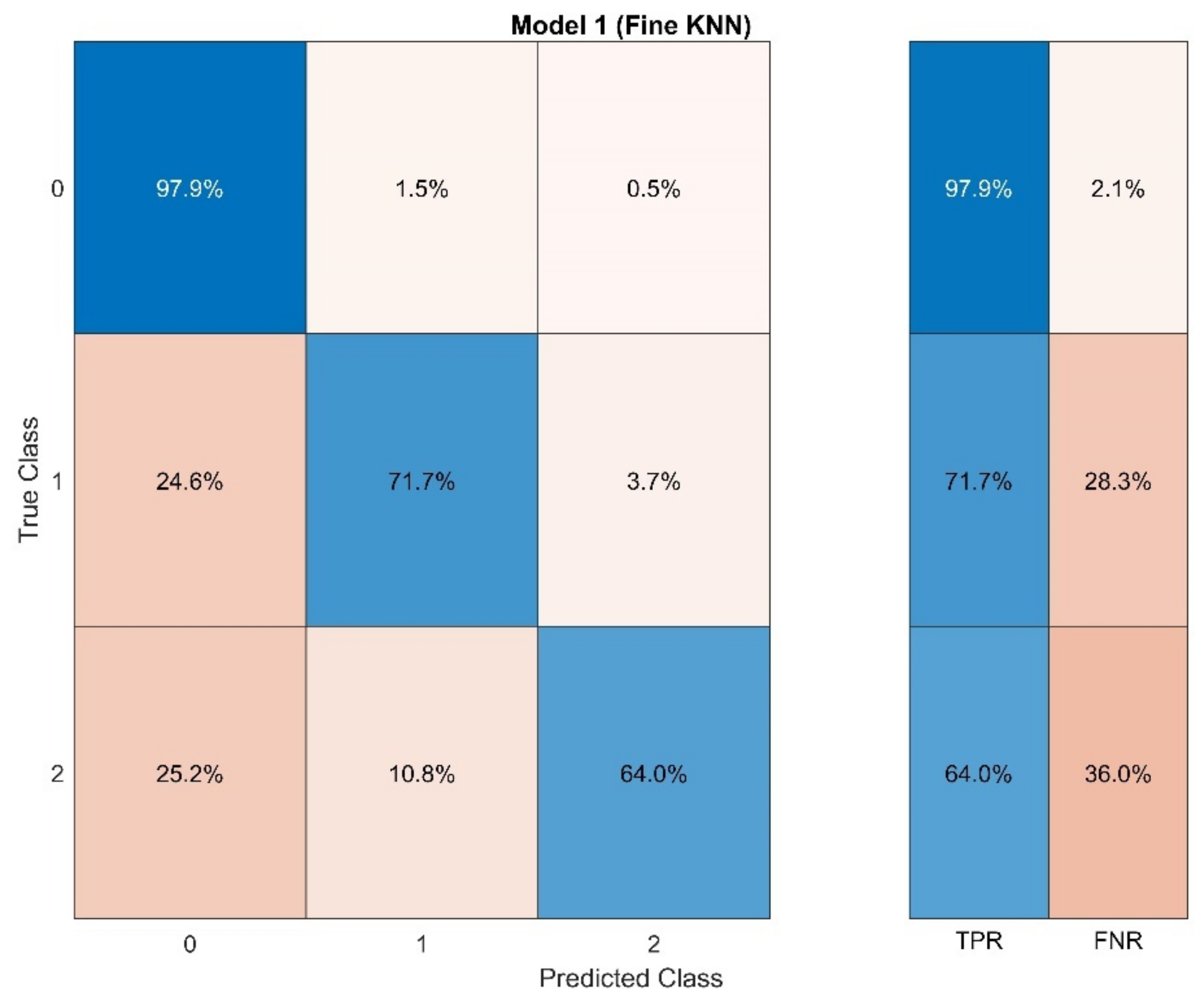

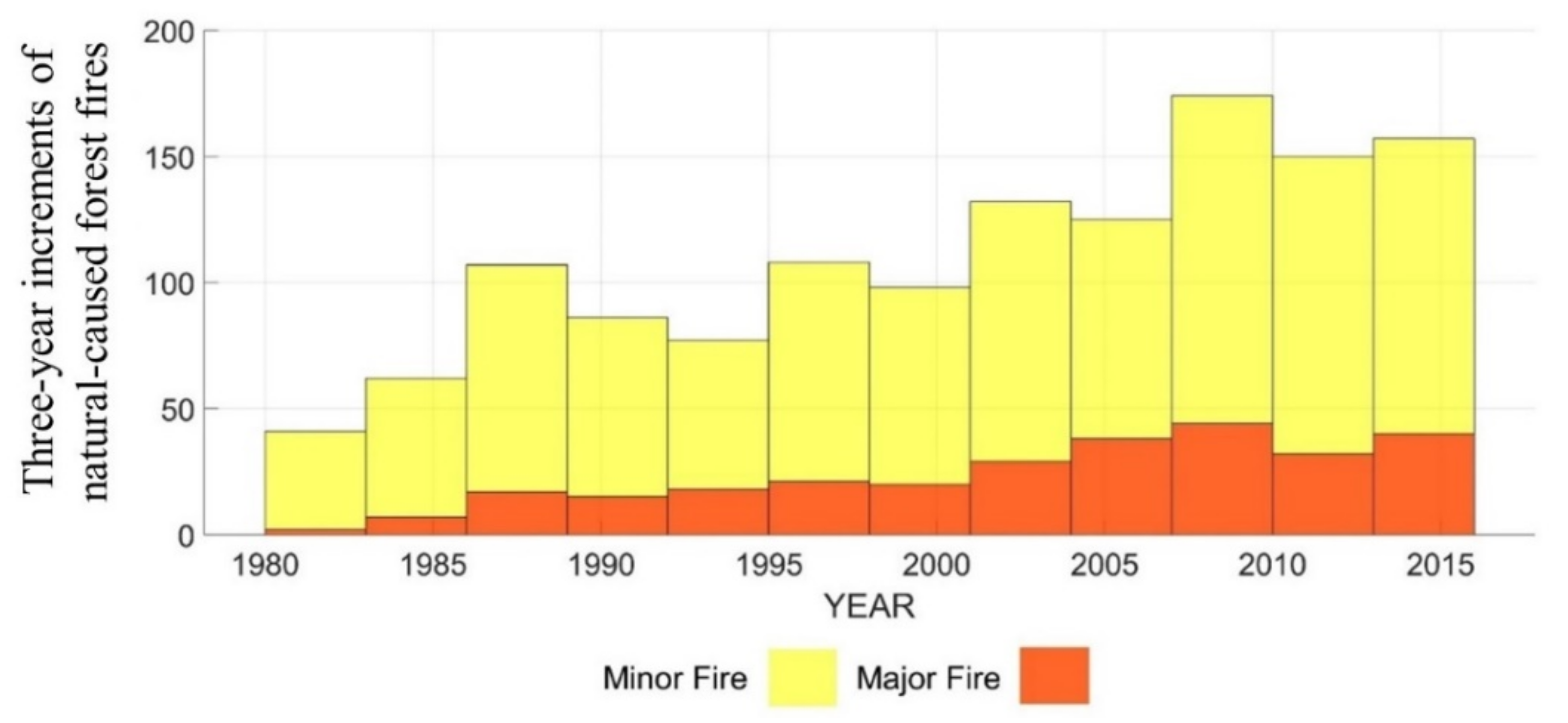
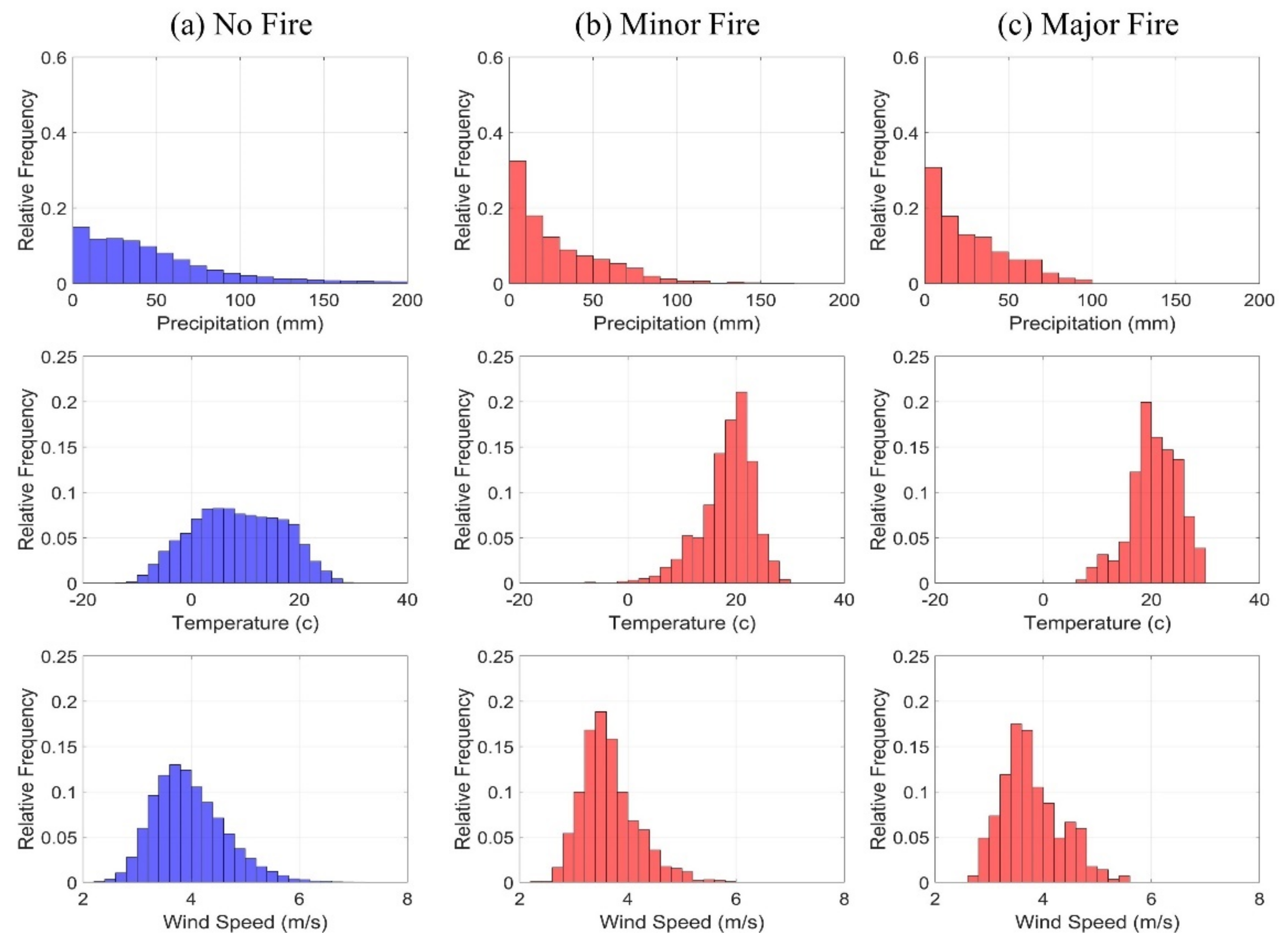

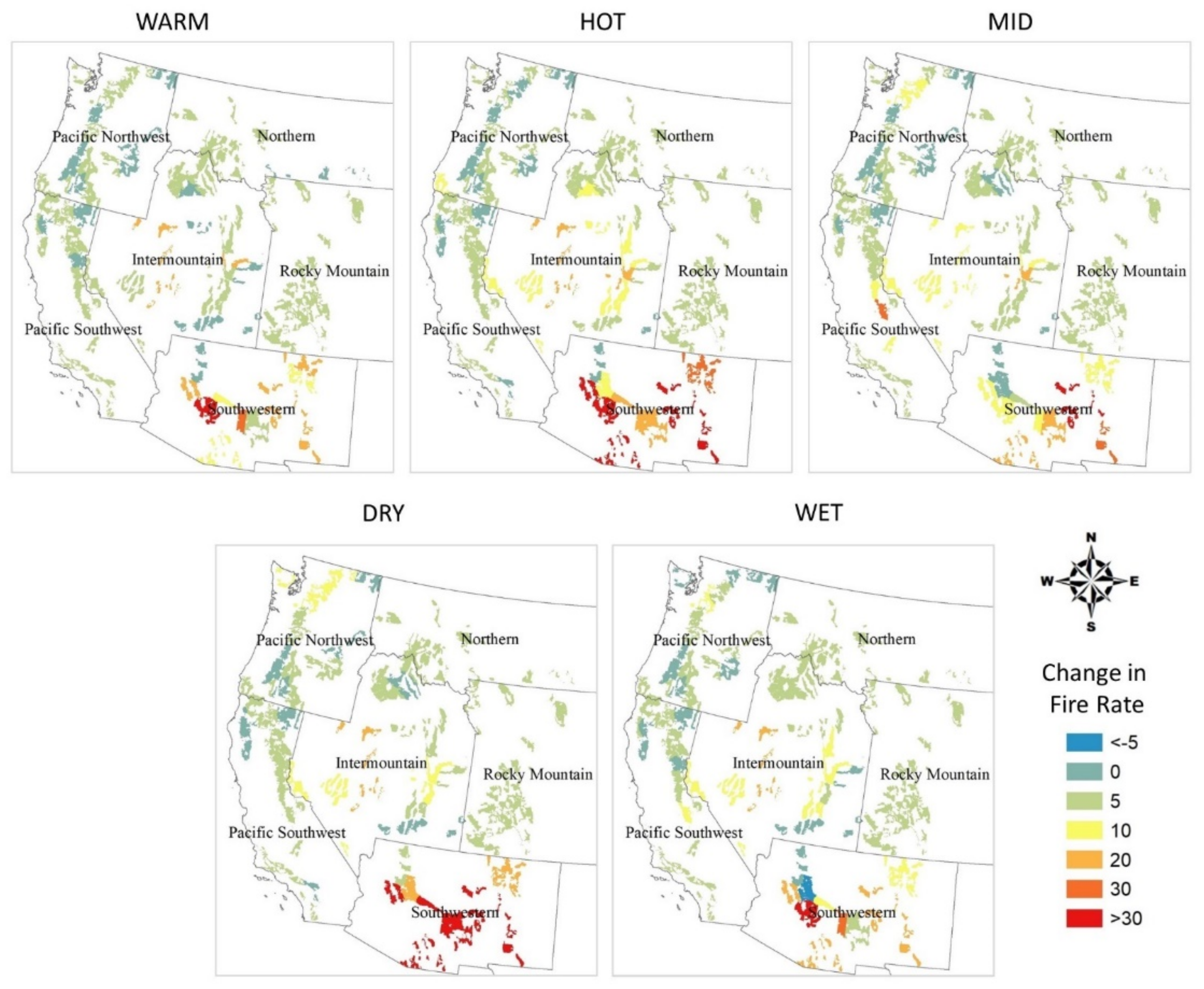
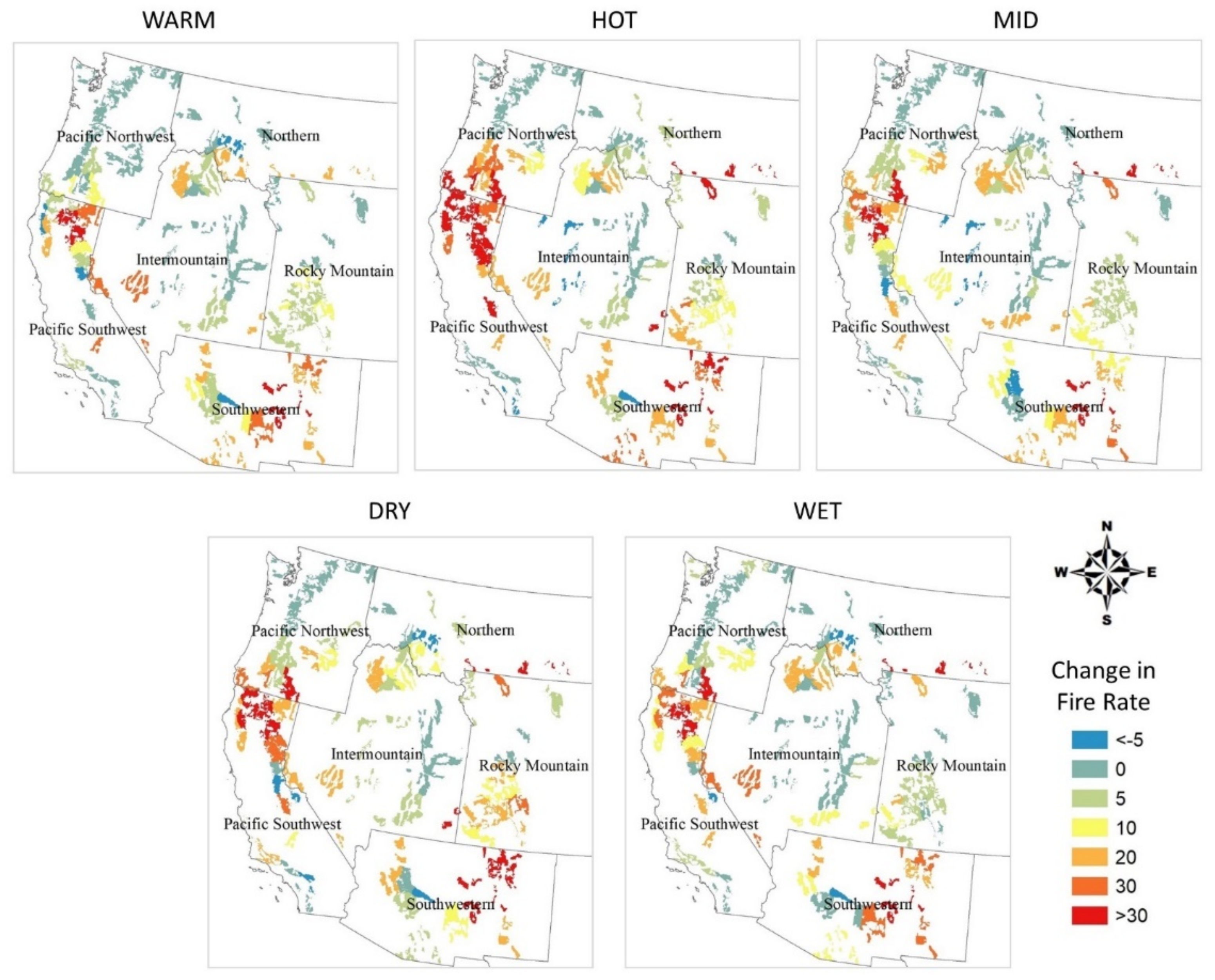
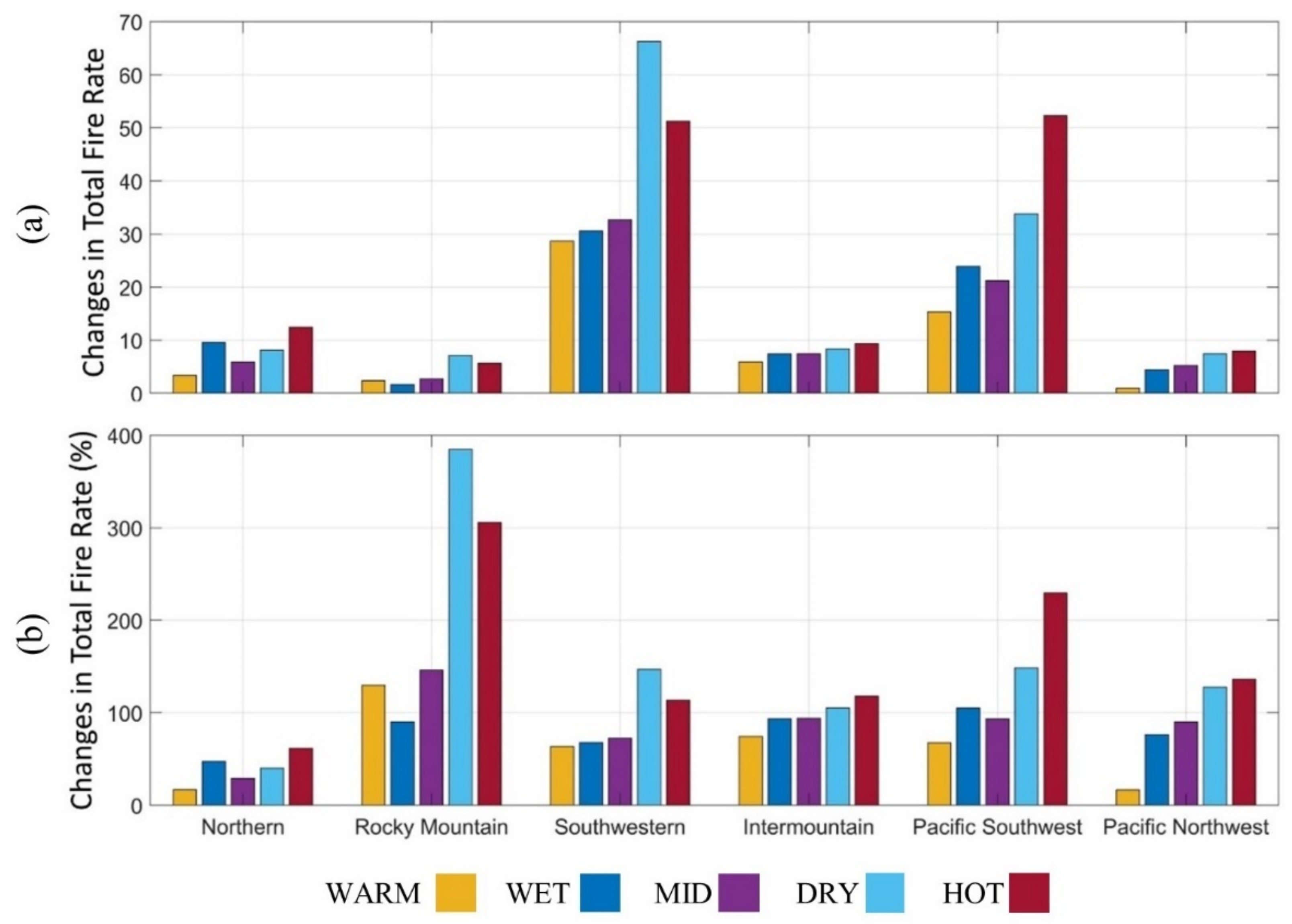

| Kolmogorov–Smirnov Test | |||
|---|---|---|---|
| Test Decision (h) | p-Value | Test Statistic (k) | |
| Precipitation | 1 | 2.27 × 10−67 | 0.2457 |
| Temperature | 1 | 0 | 0.5668 |
| Wind Speed | 1 | 1.13 × 10−55 | 0.2234 |
Publisher’s Note: MDPI stays neutral with regard to jurisdictional claims in published maps and institutional affiliations. |
© 2021 by the authors. Licensee MDPI, Basel, Switzerland. This article is an open access article distributed under the terms and conditions of the Creative Commons Attribution (CC BY) license (https://creativecommons.org/licenses/by/4.0/).
Share and Cite
Heidari, H.; Arabi, M.; Warziniack, T. Effects of Climate Change on Natural-Caused Fire Activity in Western U.S. National Forests. Atmosphere 2021, 12, 981. https://doi.org/10.3390/atmos12080981
Heidari H, Arabi M, Warziniack T. Effects of Climate Change on Natural-Caused Fire Activity in Western U.S. National Forests. Atmosphere. 2021; 12(8):981. https://doi.org/10.3390/atmos12080981
Chicago/Turabian StyleHeidari, Hadi, Mazdak Arabi, and Travis Warziniack. 2021. "Effects of Climate Change on Natural-Caused Fire Activity in Western U.S. National Forests" Atmosphere 12, no. 8: 981. https://doi.org/10.3390/atmos12080981







